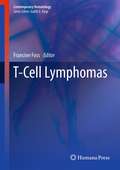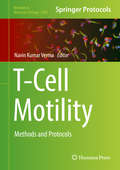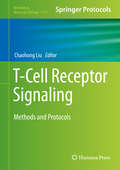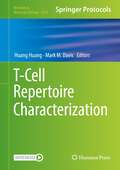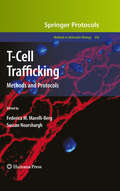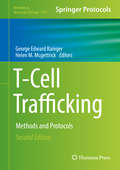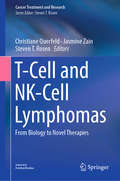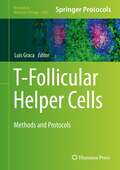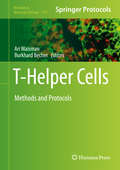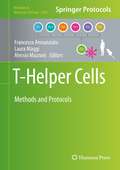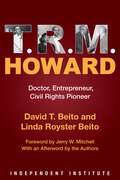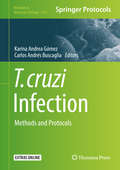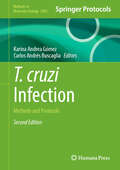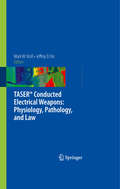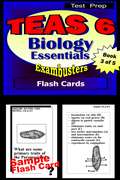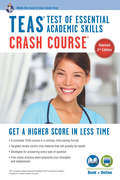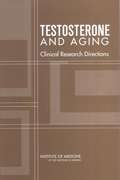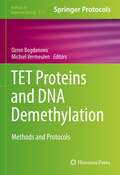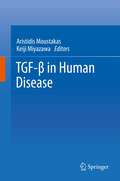- Table View
- List View
T-Cell Lymphomas
by Francine FossThe mature T and NK cell lymphomas are rare, comprising approximately 10% of all malignant lymphomas. The incidence of T-cell lymphoma is variable around the world, with a higher incidence compared to B-cell lymphomas in the Asian basin. While the overall incidence of B-cell lymphomas has begun to decline in the United States, the incidence of T-cell lymphomas continues to rise. Over the last decade, a number of novel agents have been developed which target T-cell lymphomas and studies have identified novel genes and pathways associated with lymphomagenesis in T-cells. This comprehensive volume examines the clinical and biological aspects of the T-cell lymphoproliferative disorders in adults and children. The book includes an overview of both the cutaneous and the systemic T-cell malignancies and addresses the classification of T-cell lymphomas, the clinical features of each subtype, and the relevant molecular and genetic studies. Clinical outcomes and treatment strategies are discussed with an emphasis on the development of novel biological and targeted therapies. An outstanding resource for hematologists and oncologists, this book gathers insights from experts in the field and provides the most up-to-date information on all of the T-cell lymphoma subgroups and current and emerging therapies.
T-Cell Motility: Methods and Protocols (Methods in Molecular Biology #1930)
by Navin Kumar VermaThis volume discusses the latest developments in cellular, molecular, biochemical, and imaging assays to study the biology and functions of T-cells. The chapters in this book cover topics such as LFA-1/ICAM-1 interactions in T-cell motility; using 3D-SIM to dissect signaling cross-talks in motile T-cells; GapmeR-mediated gene silencing in motile T-cells; activity of cellular kinases in migrating T-cells; and computational analysis of protein-protein interactions in motile T-cells. Written in the highly successful Methods in Molecular Biology series format, chapters include introductions to their respective topics, lists of the necessary materials and reagents, step-by-step, readily reproducible laboratory protocols, and tips on troubleshooting and avoiding known pitfalls.Cutting-edge and comprehensive, T-Cell Motility: Methods and Protocols is an essential resource for graduate students, postdoctoral fellows, and principal investigators working in the fields of immunology, T-cell biology, biochemistry, molecular biology, and imaging.
T-Cell Receptor Signaling: Methods and Protocols (Methods in Molecular Biology #2111)
by Chaohong LiuThis volume provides current and new advanced methods and protocols to study T cells. Chapters guide readers through T cell diversity using mass cytometry, analyzing T cells from single cell level, CRISPR/Cas9 techniques to study the T cell activation, techniques to study subsets of Tcell’s, procedures to study artificial antigen presentosomes for T cell activation, techniques to study the T cell development, two-photon microscopy, and MAIT cells. Written in the highly successful Methods in Molecular Biology series format, chapters include introductions to their respective topics, lists of the necessary materials and reagents, step-by-step, readily reproducible laboratory protocols, and tips on troubleshooting and avoiding known pitfalls. Authoritative and cutting-edge, T-Cell Receptor Signaling: Methods and Protocols aims to provide a wide range of approaches and be an invaluable resource for present and future generations of T cell researchers.
T-Cell Repertoire Characterization (Methods in Molecular Biology #2574)
by Mark M. Davis Huang HuangThis volume provides a comprehensive compilation of protocols in T cell repertoire analysis, from the leading experts in the field, representing both well-established methods and cutting-edge advances. Chapters broadly cover the emerging new T cell subsets, sequencing technologies for capturing TCR repertoire, and computational tools for analyzing an ever-growing TCR repertoire, with a particular focus on how to link the sequence with TCR antigen specificity. Written in the successful Methods in Molecular Biology series format, chapters include introductions to their respective topics, lists of the necessary materials and reagents, step-by-step, readily reproducible protocols, and notes on troubleshooting and avoiding known pitfalls. Authoritative and cutting-edge, T-Cell Repertoire Characterization aims to be a useful practical guide to researches to help further their study in this field.
T-Cell Trafficking
by Federica M. Marelli-Berg Sussan NoursharghIn the last decade, a large number of major discoveries have shed light on the molecular mechanisms of lymphocyte migration and the anatomy of immune responses. In T-Cell Trafficking: Methods and Protocols, expert researchers explore how the development of novel and cutting-edge techniques, particularly in the field of real-time imaging and genetic manipulation, have led to an increased understanding of lymphocyte trafficking. Written by internationally recognized experts in their respective fields, chapters provide state-of-the-art protocols to study lymphocyte migration and T-cell: endothelial cell interactions in vitro, address various approaches used for direct visualization of the development of the lymphoid system, lymphocyte recirculation, and effector responses in experimental models in vivo, and explore lymphocyte migration and inflammation in the human system. Composed in the highly successful Methods in Molecular BiologyTM series format, each chapter contains a brief introduction, step-by-step methods, a list of necessary materials, and a Notes section which shares tips on troubleshooting and avoiding known pitfalls. Innovative and highly practical, T-Cell Trafficking: Methods and Protocols is an essential manual for newcomers in this ever-expanding and exciting area of research, as well as a valuable addition to more specialized laboratories.
T-Cell Trafficking
by George Edward Rainger Helen M. McgettrickThis second edition provides updated and new chapters on T-Cell trafficking. In addition to detailed experimental procedures, the interested reader will find informative introductory chapters on the relevance of T-Cell trafficking in thymic population and maturation, traffic through secondary lymphoid organs during 'physiological' resolving inflammation and during immune responses, as well as T-Cell trafficking in chronic inflammatory diseases. Importantly, chapters cover methods from in silico modeling of cellular interactions, in vitro adhesion assays, through ex vivo functional assays to integrated intravital modeling of T-Cell trafficking through organs. Written in the highly successful Methods in Molecular Biology series format, each methods chapter includes a short introduction to the topic, lists of the necessary materials and reagents, step-by-step, readily reproducible laboratory protocols, and tips on troubleshooting and avoiding known pitfalls. Authoritative and practical, T-Cell Trafficking: Methods and Protocols, Second Edition aims to be an essential point of reference for those new to the field of T-Cell trafficking, or to those looking to expand their technical capabilities.
T-Cell and NK-Cell Lymphomas: From Biology to Novel Therapies (Cancer Treatment and Research #176)
by Jasmine Zain Christiane Querfeld Steven T. RosenIn this book, a group of internationally distinguished lymphoma experts provide a comprehensive review of the most important advances in the biology, diagnosis, and therapy of T cell and NK cell malignancies. In particular, it demonstrates in detail how advances in our understanding of the tumor microenvironment and molecular biology have helped to elucidate the pathogenesis of these lymphomas, improve diagnostic and prognostic accuracy, and develop novel therapies that promise improved patient outcomes. Individual chapters are devoted to particular tumor types and subtypes, and all aspects of transplantation for patients with T cell and NK cell lymphomas are discussed. As such, the book offers a valuable resource for hematologists, oncologists, hematopathologists, and all those seeking an up-to-date overview of how new, targeted therapies are delivering better disease control and improved quality of life.
T-Follicular Helper Cells: Methods and Protocols (Methods in Molecular Biology #2380)
by Luis GracaThe volume provides a comprehensive overview of methods that have been developed for the study of Tfh and Tfr biology in mice, and in different human diseases. The chapters detail methods to investigate the function of Tfh cells in vivo and in vitro, including the use of mathematical models to study GC dynamics. Written in the highly successful Methods in Molecular Biology series format, chapters include introductions to their respective topics, lists of the necessary materials and reagents, step-by-step, readily reproducible laboratory protocols, and tips on troubleshooting and avoiding known pitfalls. Authoritative and cutting-edge, T-Follicular Helper Cells: Methods and Protocols aims to be a useful practical guide to researchers to help further their study in this field.
T-Helper Cells
by Ari Waisman Burkhard BecherT-Helper Cells: Methods and Protocols presents a broad selection of cutting edge protocols that will enable the reader to capture the unique features of TH cells with tools developed for the isolation of TH cells from various tissues and subsequent analysis of their functional properties in vitro, ex vivo and in vivo. Chapters cover methods of isolating T cells from various tissues in mice, protocols for the analysis of T cell function and phenotype using various cutting edge technologies, methods allowing for the manipulation of T cell function in vitro and in vivo and in vivo models of diseases in which T cells play a central role in the pathogenesis. Written in the successful Methods in Molecular Biology series format, chapters include introductions to their respective topics, lists of the necessary materials and reagents, step-by-step, readily reproducible protocols, and notes on troubleshooting and avoiding known pitfalls. Authoritative and easily accessible, T-Helper Cells: Methods and Protocols seeks to serve both professionals and novices with its well-honed methodologies in an effort to further the study of this amazingly versatile and potent cell type.
T-Helper Cells: Methods and Protocols (Methods in Molecular Biology #2285)
by Francesco Annunziato Laura Maggi Alessio MazzoniThe aim of this volume is to provide a comprehensive description of methods and protocols useful for the further study of T-helper cells. Chapters guide readers through T-helper cell recovery, molecular study, signal transduction pathways, T-cell manipulation and, last but not least, “omic” approaches. Written in the highly successful Methods in Molecular Biology series format, chapters include introductions to their respective topics, lists of the necessary materials and reagents, step-by-step, readily reproducible laboratory protocols, and tips on troubleshooting and avoiding known pitfalls. Authoritative and cutting-edge, T- Helper Cells: Methods and Protocols aims to be a useful practical guide to researches to help further their study in this field.
T. R. M. Howard: Doctor, Entrepreneur, Civil Rights Pioneer
by David T. Beito Linda Royster Beito Jerry W. MitchellT.R.M. Howard: Doctor, Entrepreneur, Civil Rights Pioneer tells the remarkable story of one of the early leaders of the Civil Rights Movement.A renaissance man, T.R.M. Howard (1908-1976) was a respected surgeon, important black community leader, and successful businessman. Howard's story reveals the importance of the black middle class, their endurance and entrepreneurship in the midst of Jim Crow, and their critical role in the early Civil Rights Movement. In this powerful biography, David T. Beito and Linda Royster Beito shine a light on the life and accomplishments of this civil rights leader. Howard founded black community organizations, organized civil rights rallies and boycotts, championed free enterprise and the Second Amendment, critiqued Big Government and socialism, mentored Medgar Evers, fought the Ku Klux Klan, and helped lead the fight for justice for Emmett Till and others. Raised in poverty and witness to racial violence from a young age, Howard was passionate about justice and equality. Ambitious, zealous, and sometimes paradoxical, T.R.M. Howard provides a complete and fascinating portrait of an important leader all too often forgotten.
T. cruzi Infection: Methods and Protocols (Methods in Molecular Biology #1955)
by Karina Andrea Gómez Carlos Andrés BuscagliaThis volume provides detailed descriptions on cutting-edge experimental methods to assess the multiple and complex interactions between T. cruzi and its host. Chapters detail a series of methods and protocols, ranging from rather classical biochemical/genetic approaches to modern, powerful and high-throughput ‘-omics’ technologies, to tackle this issue, as well as novel techniques to improve treatment and clinical evaluation of Chagasic patients. Genome-wide mining strategies aimed at identifying potential parasite antigens and vaccine candidates and an overview on the challenges and milestones encountered during T. cruzi genome assembly are also included. Written in the highly successful Methods in Molecular Biology series format, chapters include introductions to their respective topics, lists of the necessary materials and reagents, step-by-step, readily reproducible laboratory protocols, and tips on troubleshooting and avoiding known pitfalls.Authoritative and cutting-edge, T. cruzi Infection: Methods and Protocols aims to provide students, researchers, and clinicians who are interested in the study of Chagas disease an indispensable source of information.
T. cruzi Infection: Methods and Protocols (Methods in Molecular Biology #2982)
by Karina Andrea Gómez Carlos Andrés BuscagliaThis fully updated volume explores experimental methods to assess the complex interactions between Trypanosoma cruzi and its host and to study different aspects of T. cruzi and Chagas disease. The techniques presented, which touch on areas of bioinformatics, biochemistry, genetics, and cell biology research, have been recently developed or adapted to the T. cruzi system by leading experts in the field. Written for the highly successful Methods in Molecular Biology series, chapters include introductions to their respective topics, lists of the necessary materials and reagents, step-by-step and readily reproducible laboratory protocols, and tips for troubleshooting and avoiding known pitfalls. Authoritative and practical, T. cruzi Infection: Methods and Protocols, Second Edition provides a comprehensive understanding of the basic biology of this parasite and its crosstalk with the host immune response that aims to inspire further understanding of Chagas disease epidemiology, diagnosis, treatment, and clinical evaluation.
T.O.s Finding Fitness
by Terrell Owens Buddy Primm Courtney ParkerAt the top of his game and his sport, Dallas Cowboys' wide receiver Terrell Owens has a phenomenal body: Muscle & Fitness magazine said this when they chose T. O. for the cover, but anyone who's ever seen him play knows he has the best physique in football. Strong, fast, agile, and focused -- when T. O. takes the field, he's in complete control. Such mastery might seem out of reach for an ordinary athlete or someone just starting to think about getting in shape, but T. O. believes that everyone is c...
T1-Mapping in Myocardial Disease: Principals And Applications
by Phillip C. YangThis book details the advances in cardiac MRI that have enabled quantitative tissue characterization of the myocardium using myocardial and blood T1 measurements, which have enabled reliable detection of diffuse pathological processes in both the cardiomyocytes and the interstitial cells of the myocardium. Evaluation of the native myocardial and interstitial fibrosis, and measurement of the extracellular volume fraction has allowed an unprecedented opportunity to elucidate the pathology, diagnosis and prognosis of cardiovascular disease. T1-Mapping in Myocardial Disease: Principles and Applications reviews a wide spectrum of significant cardiovascular disease and provides relevant guidance for the clinical implementation of this innovative technique. The specific topics covered include principles of T1-mapping in cardiovascular disease and the role of T1-mapping in hypertensive heart disease and hypertrophic cardiomyopathy, cardiotoxicity from cancer treatment, cardiacfibrosis, left ventricular hypertrophy in aortic stenosis, peri-infarct injury in ischemic cardiomyopathy, and stem cell therapy. This comprehensive coverage of the utility of T1-mapping in cardiovascular diseases will greatly appeal to the entire cardiovascular medicine and imaging communities.
TASER® Conducted Electrical Weapons: Physiology, Pathology, and Law
by Jeffrey D. Ho Mark W. KrollTASER® Conducted Electrical Weapons are rapidly replacing the club for law-enforcement control of violent subjects within many countries around the globe. A TASER CEW is a hand-held device that delivers a 400-volt pulse with a duration tuned to control the skeletal muscles without affecting the heart at a distance of up to 6.5 meters over tiny wires. If necessary, it begins with an arcing voltage of 50,000 V to penetrate thick clothing; the 50,000 V is never delivered to the body itself. Due to the widespread usage of these devices and the widespread misconceptions surrounding their operation, this book will have significant utility. This volume is written for cardiologists, emergency physicians, pathologists, law enforcement management, corrections personnel, and attorneys.
TEAS 6 Test Prep Flash Cards: Algebra Essentials (Exambusters TEAS 6 Workbook #2 of 5)
by Ace Inc.<P><P><i>Advisory: Bookshare has learned that this book offers only partial accessibility. We have kept it in the collection because it is useful for some of our members. Benetech is actively working on projects to improve accessibility issues such as these.</i><P><P> 450 questions and answers that highlight introductory algebra definitions, problems, and concepts. <P><P>Topics: Algebraic Concepts, Sets, Variables, Exponents, Properties of Numbers, Simple Equations, Signed Numbers, Monomials, Polynomials, Additive and Multiplicative Inverse, Word Problems, Prime Numbers, Factoring, Algebraic Fractions, Ratio and Proportion, Variation, Radicals, Quadratic Equations<P>Exambusters TEAS 6 Prep Workbooks provide comprehensive, fundamental TEAS V review--one fact at a time--to prepare students to take practice TEAS V tests. Each TEAS V study guide focuses on one specific subject area covered on the TEAS V exams. From 300 to 600 questions and answers, each volume in the TEAS V series is a quick and easy, focused read. Reviewing TEAS V flash cards is the first step toward more confident TEAS V preparation and ultimately, higher TEAS V exam scores!
TEAS 6 Test Prep Flash Cards: Arithmetic Essentials (Exambusters TEAS 6 Workbook #1 of 5)
by Ace Inc.<P><P><i>Advisory: Bookshare has learned that this book offers only partial accessibility. We have kept it in the collection because it is useful for some of our members. Benetech is actively working on projects to improve accessibility issues such as these.</i><P><P> 600 questions and answers highlight essential arithmetic definitions, problems, and concepts.<P><P> Topics: Addition, Subtraction, Multiplication, and Division of Whole Numbers; Fractions and Decimals, Multiplication Tables, Word Problems, Percents, Measurement, Metric System, Square Roots and Powers, Real Numbers, Properties of Numbers <P>Exambusters TEAS 6 Prep Workbooks provide comprehensive, fundamental TEAS V review--one fact at a time--to prepare students to take practice TEAS V tests. Each TEAS V study guide focuses on one specific subject area covered on the TEAS V exams. From 300 to 600 questions and answers, each volume in the TEAS V series is a quick and easy, focused read. Reviewing TEAS V flash cards is the first step toward more confident TEAS V preparation and ultimately, higher TEAS V exam scores!
TEAS 6 Test Prep Flash Cards: Biology Essentials (Exambusters TEAS 6 Workbook #3 of 5)
by Ace Inc.<P><P><i>Advisory: Bookshare has learned that this book offers only partial accessibility. We have kept it in the collection because it is useful for some of our members. Benetech is actively working on projects to improve accessibility issues such as these.</i><P><P> 450 questions and answers. Essential definitions and concepts. <P><P>Topics: Cells, Biochemistry and Energy, Evolution and Classification, Kingdoms: Bacteria, Fungi, Protista; Kingdom: Plantae, Kingdom: Animalia, Human Locomotion, Human Circulation and Immunology, Human Respiration and Excretion, Human Digestion, Human Nervous System, Human Endocrinology, Reproduction and Development, Genetics, Ecology <P>Exambusters TEAS 6 Prep Workbooks provide comprehensive, fundamental TEAS V review--one fact at a time--to prepare students to take practice TEAS V tests. Each TEAS V study guide focuses on one specific subject area covered on the TEAS V exams. From 300 to 600 questions and answers, each volume in the TEAS V series is a quick and easy, focused read. Reviewing TEAS V flash cards is the first step toward more confident TEAS V preparation and ultimately, higher TEAS V exam scores!
TEAS 6 Test Prep Flash Cards: Chemistry Essentials (Exambusters TEAS 6 Workbook #4 of 5)
by Ace Inc.<P><P><i>Advisory: Bookshare has learned that this book offers only partial accessibility. We have kept it in the collection because it is useful for some of our members. Benetech is actively working on projects to improve accessibility issues such as these.</i><P><P> 700 questions and answers. Essential definitions, formulas, concepts, and sample problems. <P><P>Topics: Introduction, Matter, Atoms, Formulas, Moles, Reactions, Elements, Periodic Table, Electrons, Chemical Bonds, Heat, Gases, Phase Changes, Solutions, Reaction Rates, Equilibrium, Acids and Bases, Oxidation and Reduction, Introduction to Organic Chemistry, Radioactivity <P>Exambusters TEAS 6 Prep Workbooks provide comprehensive, fundamental TEAS V review--one fact at a time--to prepare students to take practice TEAS V tests. Each TEAS V study guide focuses on one specific subject area covered on the TEAS V exams. From 300 to 600 questions and answers, each volume in the TEAS V series is a quick and easy, focused read. Reviewing TEAS V flash cards is the first step toward more confident TEAS V preparation and ultimately, higher TEAS V exam scores!
TEAS 6 Test Prep Flash Cards: Vocabulary Essentials (Exambusters TEAS 6 Workbook #5 of 5)
by Ace Inc.<P><P><i>Advisory: Bookshare has learned that this book offers only partial accessibility. We have kept it in the collection because it is useful for some of our members. Benetech is actively working on projects to improve accessibility issues such as these.</i><P><P> 350 frequently tested words every college graduate should know. Perfect for anyone who wants to enrich their vocabulary! Improve your reading comprehension and conversation. Includes sample sentence, part of speech, pronunciation, succinct, easy-to-remember definition, and common synonyms and antonyms. <P><P>Exambusters TEAS 6 Prep Workbooks provide comprehensive, fundamental TEAS V review--one fact at a time--to prepare students to take practice TEAS V tests. Each TEAS V study guide focuses on one specific subject area covered on the TEAS V exams. From 300 to 600 questions and answers, each volume in the TEAS V series is a quick and easy, focused read. Reviewing TEAS V flash cards is the first step toward more confident TEAS V preparation and ultimately, higher TEAS V exam scores!
TEAS Crash Course Book + Online (Nursing Test Prep)
by Daniel GreenbergREA's TEAS Crash Course Book + Online Practice Test Fully Revised Second EditionEverything you need for the exam - in a fast review format! REA's TEAS (Test of Essential Academic Skills) Crash Course is the first book of its kind for the last-minute studier or anyone who wants to get a high score on this nursing school entry exam. Targeted, Focused Review - Study Only What You Need to Know Based on the Test of Essential Academic Skills exam and actual TEAS questions, the Crash Course covers only the information tested on the exam, so you can make the most of your study time. Targeted, easy-to-read review chapters in outline format cover reading comprehension, English language and usage, math, biology, chemistry, physics, and more. Expert Test-taking Strategies Our author explains the structure of the TEAS, so you know what to expect on test day. He also shares detailed question-level strategies and shows you the best way to answer questions. By following our expert tips and advice, you can score higher on every section of the exam. Take REA's Online Practice Exam After studying the material in the TEAS Crash Course, go online and test what you've learned. Our practice exam features timed testing, diagnostic feedback, detailed explanations of answers, and automatic scoring analysis. The exam is balanced to include every topic and type of question found on the TEAS exam, so you know you're studying the smart way. No matter how or when you prepare for the TEAS exam, REA's TEAS Crash Course will show you how to study efficiently and strategically, so you can get a higher score in less time!
TESTOSTERONE AND AGING: Clinical Research Directions
by Institute of Medicine of the National AcademiesPopular culture often equates testosterone with virility, strength, and the macho male physique. Viewed by some as an “antiaging tonic,” testosterone’s reputation and increased use by men of all ages in the United States have outpaced the scientific evidence about its potential benefits and risks. In particular there has been growing concern about an increase in the number of middle-aged and older men using testosterone and the lack of scientific data on the effect it may have on aging males. Studies of testosterone replacement therapy in older men have generally been of short duration, involving small numbers of participants and often lacking adequate controls. Testosterone and Aging weighs the options of future research directions, examines the risks and benefits of testosterone replacement therapy, assesses the potential public health impact of such therapy in the United States, and considers ethical issues related to the conduct of clinical trials. Testosterone therapy remains an attractive option to many men even as speculation abounds regarding its potential.
TET Proteins and DNA Demethylation: Methods and Protocols (Methods in Molecular Biology #2272)
by Ozren Bogdanovic Michiel VermeulenThis volume explores the latest methods used to study various aspects of TET proteins and their biology. Chapters in this book are divided into five parts. Part One describes technologies aimed at detecting and quantifying DNA methylation turnover using massively parallel sequencing, ELISA, and mass spectrometry approaches. Part Two looks at data analyses protocols for distinguishing acting versus passive DNA demethylation and estimation of 5mC and 5hmC levels. Part Three deals with a new topic that takes advantage of modified CRISPR/Cas9 genome editing systems to target DNA demethylation activity to genomic loci of interest. Part Four discusses protocols that detail how to purify TET proteins and unravel their protein interactions, and Part Five looks at the assessment of TET protein function and activity in vivo and in vitro. Written in the highly successful Methods in Molecular Biology series format, chapters include introductions to their respective topics, lists of the necessary materials and reagents, step-by-step, readily reproducible laboratory protocols, and tips on troubleshooting and avoiding known pitfalls. Cutting-edge and thorough, TET Proteins and DNA Demethylation: Methods and Protocols is a valuable resource that aims to help research scientists at all levels working in the fields of DNA demethylation dynamics.Chapters 3, 7 and 17 are available open access under a Creative Commons Attribution 4.0 International License via link.springer.com.
TGF-β in Human Disease
by Aristidis Moustakas Keiji MiyazawaTransforming growth factor-β (TGF-β) is a secreted polypeptide with multifunctional properties manifested during embryonic development, adult organ physiology, and pathobiology of major diseases, including cancer and fibrotic and cardiovascular diseases. The signaling pathway of TGF-β now is rather well understood. Continuing revelations in the mechanisms of action of TGF-β provide specific mechanistic examples of how human cells lose their controlled function and behave wrongly during the development of diverse diseases. Equally important, however, is the current promise of exploiting the TGF-β pathway in combating human disease. This book comprehensively covers major areas of human disease where the involvement of TGF-β is firmly established. Simultaneously, the book highlights major gaps in knowledge and the future directions of research that can benefit human medical science. The core set of diseases where TGF-β action is well documented and are included in the book are cancer and cardiovascular and fibrotic disorders. The central aim of the book is to stimulate young scientists to enter the prolific TGF-β field and find new solutions to the problems remaining in this area of study. For this purpose the book provides authoritative educational chapters that furnish a good introduction to the field for young doctoral students, postdocs, and clinical fellows. The book also serves as a valuable reference for the aficionados in the field, who can find accessible and well-illustrated material for their teaching and lecturing activities, via which the importance of TGF-β biology is disseminated to the world of science and to the public.
